May 10, 2010 – 07:35 am ET
…And when she was bad she was horrid! The warning signs of a market tantrum have around for some time now and were clear enough for us to cash up all bullish positions as mentioned in our last newsletter – Cashed Up With A Few Shorts.
April 12, we cautioned “This 2nd wind can create some impressive gains but usually on light volume and when it ends it tends to end in tears… When risk levels are perceived to be low the market is more easily spooked and this tends to lead to sharper and more severe reversals.”
If the last week has been anything it has been a sharp and severe reversal. If this kind of analysis has been of use to you then please spread the word about this newsletter. We also identified the beginning of the last bullish leg and shared the analysis we used to do so with you for free. So please get on twitter, the chat rooms, newsgroups, Facebook, email etc and help us grow. Thanks. We are certainly not always right but simply look to work with the probabilities.
.
ETF % Change Comparison
.

When you stop and look at the numbers they are quite scary. Don Beasley said that “Market Timing is winning by not losing” and we were certainly able to avoid some significant losses over the last week and lock in some tasty gains. The more economically sensitive SMH, QQQQ, IWM and IYT are the furthest from their highs indicating that these declines are likely to be more than just profit taking.
.
What the % Comparison Table Tells Us:
By comparing the performance of the economically sensitive (SMH, QQQQ, IWM, IYT) and the comparatively stable ETFs (SPY and DIA) we can get an indication of the true market direction. The more sensitive areas of the market tend to be the first to initiate a trend change. For example if DIA and SPY sell off heavily while SMH and IWM (Russell 2000 small cap ETF) sell of mildly or continue moving to new highs then this would be very positive and vice versa.
The ‘Average Rank %’ is calculated by subtracting the % change for each ETF from the maximum % change and dividing it by the range for each period. 1-((MAX(% change all ETFs)-ETFs % Change)/(MAX(% change all ETFs)-MIN(% change all ETFs))) The readings for each period are then averaged. This reading is provided because if one ETF was significantly under/out performing the others then a plain high or low rank would not accurately reflect this.
.
![]()
.
A Look at the Charts
.
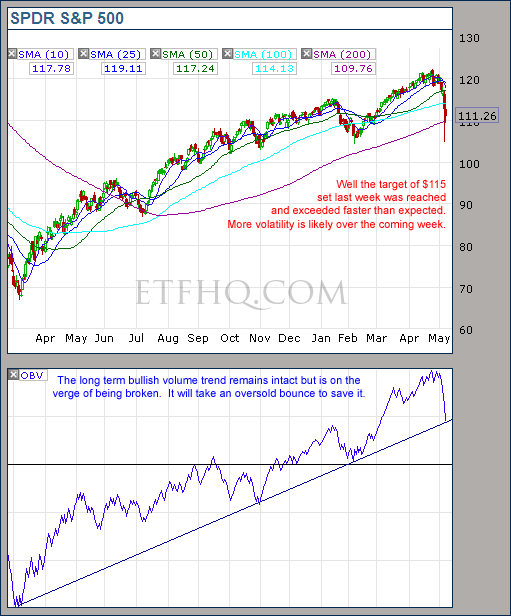
The ‘healthy targets’ set last week have all been smashed in an ‘unhealthy way’ and further volatility is likely.
.

QQQQ has broken its long term bullish trend which indicates a bearish trend change.
.
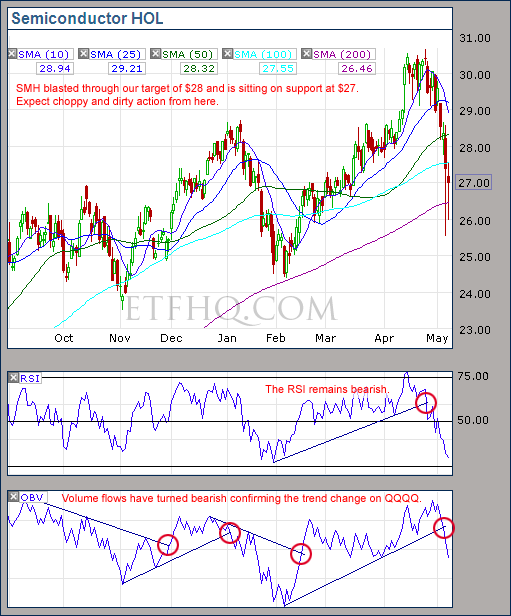
Another bearish volume trend from SMH confirming the trend change.
.
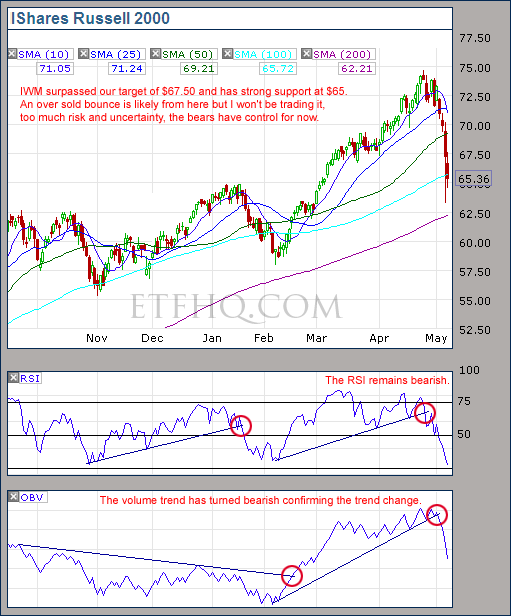
The small caps volume flows have also turned bearish.
.
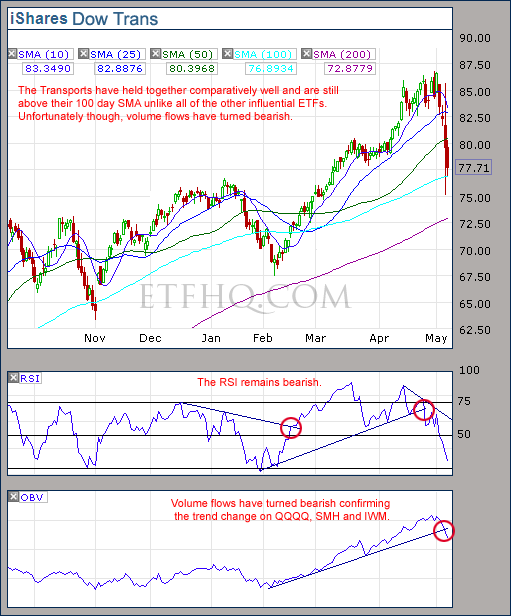
That’s four out of five with bearish volume pointing towards a return to the bear market.
.
![]()
.
OM3 Weekly Indicator
.

The OM3 indicator is not strongly bearish with a number of ‘Weak Sells’.
.
How to read the OM3 indicator
The OM3 indicator as with most of our models primarily reads price action and volume. The strong/weak buy/sell signals are self-explanatory. ‘No Signal’ means that the component readings are in conflict and cancel each other out.
The alerts let you know if the cycle is speeding up or slowing down, so when you get at ‘Strong Buy, Bear Alert’ for instance it simply means that the criteria for a strong buy is in place but this weeks cycle reading is weaker (or more bearish) than last weeks reading (the same is true in reverse).
The number of weeks that a signal has been repeated is displayed. Historically a ‘Strong Buy’ signal has lasted for an average of 6 weeks and a maximum of 42 weeks, while a ‘Strong Sell’ has lasted for an average of 4 weeks and a maximum of 16.
This is an indicator not a mechanical trading model. It is useful to assist in analyzing the market but for the best results should be combined with commonsense and support/resistance levels etc.
.
![]()
.
TransDow & NasDow
.

Now this is interesting… On Friday the NASDAQ become dominant over the Dow which is a very bullish sign and the Transports remain dominant over the Dow which is also very positive. Most of the worst market declines are seen when the Dow is dominant.
.
What the TransDow Readings tell us:
The TransDow measures dominance between the DJ Transportation Index (DJTI) and the Dow Jones Industrial Average (DJIA). In a strong market the more economically sensitive Transportation Index should be dominant over the DJIA.
Historically the DJTI has been dominant over the Dow 45% of the time. The annualized rate of return from the DJTI during this period was 18.47% with the biggest loss for one trade sitting at -13.27%. The annualized return from the DJIA during the periods it was dominant over the DJTI was just 4.06% and the biggest loss for one trade was -16.13%. A 4% stop-loss is applied to all trades adjusting positions only at the end of the week.
What the NasDow Readings tell us:
The NasDow measures dominance between the NASDAQ and the DJIA. Using the same theory behind the Trans Dow; in a strong market the more economically sensitive NASDAQ should be dominant over the DJIA.
Historically the NASDAQ has been dominant over the DJIA 44% of the time. Taking only the trades when the NASDAQ is above its 40 week moving average the annualized rate of return was 25.47% with the biggest loss for one trade sitting at –8.59%. The annualized rate on the DJIA during the periods it was dominant over the NASDAQ is just 8.88% and the biggest loss for one trade was –12.28%. A 8% stop-loss is applied to all trades adjusting positions only at the end of the week.
.
![]()
.
LTMF 80 & Liquid Q
.
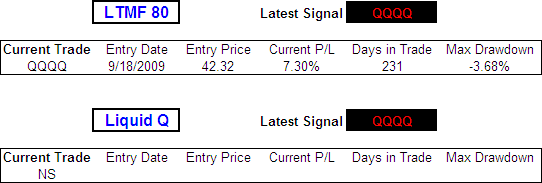
Another surprising but positive sign; Liquid Q triggered a new bullish position in QQQQ on Friday. The signal for LTMF 80 is also still active but on the verge of being closed. With the market being oversold this could turn out to be a good trade but I see it as too risky.
.
Historical Stats:
.

.
How The LTMF 80 Works
LTMF stands for Long Term Market Forecaster. It reads volume flows relative to price action and looks for out performance of volume measured on a percentage basis over the prior 12 months. During a sustained rally the readings will reach high levels (near 100%) making it imposable for the volume reading to always outperform price so any reading above 80% will maintain the buy signal. This system has outperformed the market over the last 10 years but performance has been damaged by some nasty losses. It only produces buy signals and only for QQQQ.
How Liquid Q Works
Liquid Q completely ignores price action and instead measures the relative flow of money between a selection of economically sensitive and comparatively stable ares of the market. It looks for times when the smart money is confident and and can be seen by through volume investing heavily is more risky areas due to an expectation of expansion. This system has outperformed the market over the last 10 years and remained in cash through most of the major declines. It only produces buy signals and only for QQQQ. We will provide more performance details on the web site for these systems soon.
.
![]()
.
Summary
.
Based on my discretionary technical analysis the market has completed a confirmed bearish trend change due to bearish volume flows from QQQQ, SMH, IWM and IYT along with the loss of several support levels. However in such a volatile market after such harsh declines the possibility of an oversold bounce is good. In fact looking at the market futures now I see they are well up on news about new bailouts organized for European nations burdened by heavy debt.
I am a big advocate of taking the easy trades and passing on the difficult others. You don’t have to make many good trades each year as long as you don’t make too many bad ones. This market is changing so quickly, you need to be very nimble not to get burnt.
If you are still in the market then sit on your hands for now. There are fresh buy signals from the NasDow and Liquid Q and the market has found several support levels. As long as the market maintains these levels then there is still hope for the bulls:
- SPY $110
- QQQQ $45
- SMH $27
- IWM $65
- IYT 100day SMA.
Should there be a close below these levels then there is little/no hope for the bull market.
If you are already out of the market then wait until things are more clear before going long or short. Much of the easy money has probably already gone from the short side and when volume flows are bearish it is a very risky time to go long.
.
Any disputes, questions, queries, comments or theories are most welcome in the comments section below.
.
Derry
And the Team @ ETF HQ
“Equipping you to win on Wall St so that you can reach your financial goals.”
.
P.S Like ETFHQ on Facebook – HERE
.
![]()
.
The Devils Dictionary – M.
.
Mark To Model – The use of a mathematical model to value complex securities, such as CDOs. “The combination of precise formulas with highly imprecise assumptions can be used to establish practically any value one wishes” – Ben Graham. Particularly useful to investors who wish to delay the recognition of a loss.
Market Correction – The day after you buy stocks.
Moody – State of mind after a just-issued security gets downgraded fro AAA to CCC